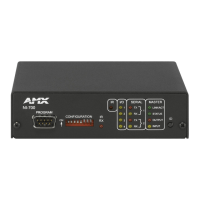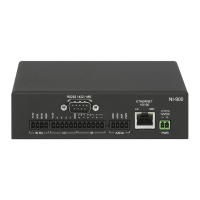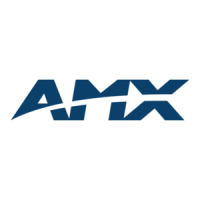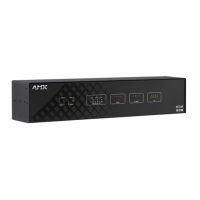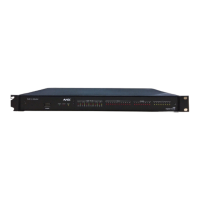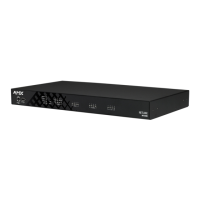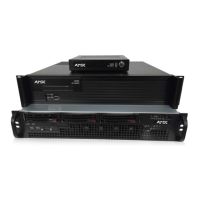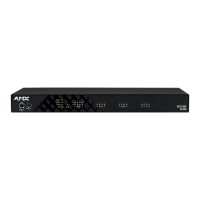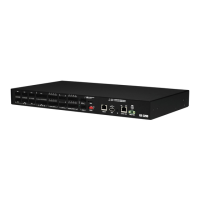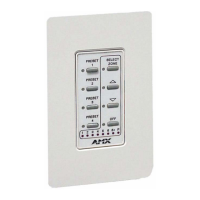Terminal (Program Port/Telnet) Commands
104
NetLinx Integrated Controllers (Firmware v4)- WebConsole & Programming Guide
Security Options Menu
Select "Set system security" from the Setup Security Menu to access the Security Options menu, described below:
Edit User Menu
The Edit User Menu is accessed whenever you enter the Add user, or Edit user selections from the Setup Security menu. The Edit
User Menu options are described in the following table:
Edit Group Menu
The Edit Group Menu is accessed whenever you enter the Add group, or Edit group selections from the Setup Security menu. The
Edit Group Menu options are described in the following table:
Security Options Menu
Command Description
1) Terminal (RS232) Security
(Enabled/Disabled)
This selection enables/disables Terminal Security. on the Program (RS232) Port.If Te rm inal Security
is enabled, a user must have sufficient access rights to login to a Program Port terminal session.
2) HTTP Security
(Enabled/Disabled)
This selection enables/disables HTTP (Web Server) Security. If HTTP Security is enabled, a user
must have sufficient access rights to access the Master’s WebConsole via a web browser.
3) Telnet Security
(Enabled/Disabled)
This selection enables/disables Telnet Security. If Te lnet Security is enabled, a user must have
sufficient access rights to login to a Telnet terminal session.
4) Configuration Security
(Enabled/Disabled)
This selection enables/disables configuration access rights for the Master. If Configuration Security
is enabled, a user must have sufficient access rights to access the Setup Security menu (see
page 102), and make changes to the Master’s security parameters.
5) ICSP Security
(Enabled/Disabled)
This selection enables/disables security of ICSP data being transmitted between the target Master
and external AMX components (software and hardware such as TPD4 and a Modero Touch Panel).
6) ICSP Encryption Required
(Enabled/Disabled)
This selection enables/disables the need to require encryption of the ICSP communicated data. If
enabled:
• All communicating AMX components must authenticate with a valid username and password
before beginning communication with the Master.
• All communication must be encrypted.
7) LDAP Security
(Enabled/Disabled)
This selection enables/disables LDAP Security. Refer to Appendix A: LDAP Implementation Details
on page 108 for details on LDAP Implementation.
Edit User Menu
Command Description
1) Change User Password
This selection prompts you to enter the new password (twice) for the user. Once the new
password is entered, the user must use the new password from that point forward.
2) Change Inherits From Group
This selection will display the current group the user is assigned to (if any). It will then display a
list of current groups and prompts you to select the new group.
3) Add Directory Association
This selection will display any current directory associations assigned to the user, and then will
prompt you for a path for the new directory association.
4) Delete Directory Association
This selection will display any current directory associations assigned to the user, and then will
prompt you to select the directory association you want to delete.
5) List Directory Associations
This selection will display any current Directory Associations assigned to the user.
6) Change Access Rights
This selection will display access the Access Rights menu, which allows you to set the rights
assigned to the user.
Note: See the Access Rights Menu section (below) for descriptions of each menu item.
7) Display User Record Contents
This selection will display the group the user is assigned to and the current Access Rights
assigned to the user.
Edit Group Menu
Command Description
3) Add Directory Association
This selection will display any current directory associations assigned to the group, and then
will prompt you for a path for the new directory association.
4) Delete Directory Association
This selection will display any current directory associations assigned to the group, and then
will prompt you to select the directory association you want to delete.
5) List Directory Associations
This selection will display any current Directory Associations assigned to the group.
6) Change Access Rights
This selection will display access the Access Rights menu, which allows you to set the rights
assigned to the group.
Note: See the Access Rights Menu section (below) for descriptions of each menu item.
7) Display Access Rights
This selection will display the current Access Rights assigned to the group.
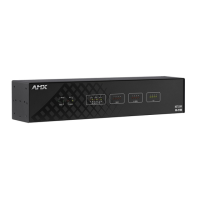
